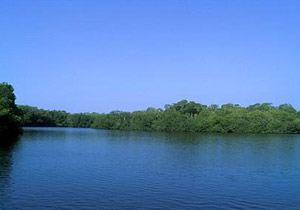
Mangrove in Equador
On July 26th, people in coastal regions from all over the world demonstrated against the shrimp farming industry, calling for the conservation of precious mangrove areas.
Thirty percent of the shrimp and prawns produced worldwide come from ponds carved from mangrove areas. Mangroves, the coastal equivalent of rainforests, provide homes for an amazing range of plant and animal life, support the livelihood of local communities, and defend the coast from erosion and storms. The single greatest threat to mangroves worldwide is shrimp farming - about 35 percent of mangroves worldwide have been lost in the last 20 years.
Previously a luxury item only consumed on special occasions, prawns and shrimps are now turning into an everyday product - Britain's favourite starter after all is the prawn cocktail. Consumers in the US, Japan, and the European Union - the main importers - are often not aware of the destruction that lies behind one of their favourite dishes.
Shrimp farming requires the clear-cutting of mangroves to build ponds. Once the mangroves are ripped out, the coast is rendered unstable and many creatures lose their habitat. Fish catches decline and ecosystems are knocked out of balance. The ponds are treated with antibiotics, pesticides, and fish-feeds, with the toxic mix often dumped into the surrounding land or waterways.
In addition to the loss of biodiversity, local communities depend on this coastal ecology for their food and livelihood. The destruction of mangrove areas means these communities lose their only source of income.
On July 26th, global protests took place near cities and towns where industrial shrimp farming and mangrove loss are problems. Over a dozen countries were involved including Brazil, Colombia, Ecuador, Honduras, Guatemala, Mexico, Bangladesh, India, Sri Lanka, the Philippines, Malaysia, Myanmar (Burma), Kenya, Nigeria, Germany, and the US.
It marked the beginning of a stronger international network of small-scale fisher.

